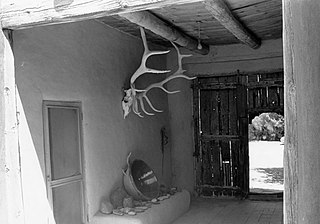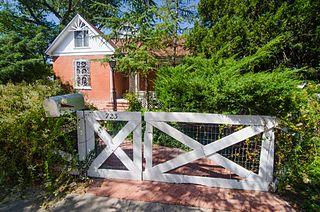
San Felipe de Neri Church is a historic Catholic church located on the north side of Old Town Plaza in Albuquerque, New Mexico. Built in 1793, it is one of the oldest surviving buildings in the city and the only building in Old Town proven to date to the Spanish colonial period. The church is listed on the New Mexico State Register of Cultural Properties and the National Register of Historic Places and has remained in continuous use for over 200 years.

The Georgia O'Keeffe Home and Studio is a historic house museum in Abiquiú, New Mexico. From 1943 until her death, it was the principal residence and studio of artist Georgia O'Keeffe (1887–1986). It is now part of the Georgia O'Keeffe Museum, which has sites in Santa Fe and Abiquiú. Public tours are available March–November, with advance tickets required. The Home and Studio became a National Historic Landmark in 1998, as one of the most important artistic sites in the southwestern United States.

El Pueblo de Los Ángeles Historical Monument, also known as Los Angeles Plaza Historic District and formerly known as El Pueblo de Los Ángeles State Historic Park, is a historic district taking in the oldest section of Los Angeles, known for many years as El Pueblo de Nuestra Señora la Reina de los Ángeles del Río de Porciúncula. The district, centered on the old plaza, was the city's center under Spanish (1781–1821), Mexican (1821–1847), and United States rule through most of the 19th century. The 44-acre park area was designated a state historic monument in 1953 and listed on the National Register of Historic Places in 1972.

There are 73 properties listed on the National Register of Historic Places in Albany, New York, United States. Six are additionally designated as National Historic Landmarks (NHLs), the most of any city in the state after New York City. Another 14 are historic districts, for which 20 of the listings are also contributing properties. Two properties, both buildings, that had been listed in the past but have since been demolished have been delisted; one building that is also no longer extant remains listed.

The Ezra Clark House is located on Mill Road in the Town of North East, New York, United States. It is a brick house built in the late 18th century.

The Rufus Piper Homestead is a historic house on Pierce Road in Dublin, New Hampshire. The house is a well-preserved typical New England multi-section farmhouse, joining a main house block to a barn. The oldest portion of the house is one of the 1+1⁄2-story ells, a Cape style house which was built c. 1817 by Rufus Piper, who was active in town affairs for many years. The house was listed on the National Register of Historic Places in 1983. The home of Rufus Piper's father, the Solomon Piper Farm, also still stands and is also listed on the National Register of Historic Places.

The Spur House is a historic house off Old Common Road in Dublin, New Hampshire. Built in 1901, it is a good local example of Colonial Revival architecture, designed by architect Charles A. Platt. The house was listed on the National Register of Historic Places in 1983.

The S. H. Kress Building is a historic commercial building in downtown Albuquerque, New Mexico. Built in 1925 by the S. H. Kress & Co. department store chain, it is notable as a well-preserved early 20th century retail building. It was added to the New Mexico State Register of Cultural Properties and the National Register of Historic Places in 1984.

The Pacific Building, also known as the Pacific Desk Building, is a historic building in Albuquerque, New Mexico. Built in 1914, it is notable as a well-preserved example of early 20th-century commercial architecture in Downtown Albuquerque and includes one of the only remaining cast iron storefronts in the central business district. The building was added to the New Mexico State Register of Cultural Properties and the National Register of Historic Places in 1980.

Monte Vista Fire Station is a historic former fire station in the Nob Hill neighborhood of Albuquerque, New Mexico. Built in 1936 using Works Progress Administration funding, it is notable as a well-preserved WPA municipal project and for its significance in the early development of the Nob Hill area. The building served in its original role as a fire station until 1972 and currently houses a restaurant. It is the city's third oldest surviving fire station after the AT&SF Fire Station, built in 1920, and the old station #2 on the corner of High St. and Silver Ave. opened in 1926.

The Berthold Spitz House is a historic house in Albuquerque, New Mexico, which is significant as the city's best example of Prairie School architecture. It was built around 1910 by Berthold Spitz and his wife Fannie Schutz Spitz (1873–1943). Berthold was a German Jewish merchant who was born in Bohemia and immigrated to Albuquerque around 1880. He ran a successful dry goods business and made a few forays into local politics before being appointed as the city's postmaster in 1921. Fannie grew up in El Paso and was notable as the inventor of the first commercial pine nut shelling machine. She was described by the Albuquerque Journal as "the greatest known authority on the piñon nut and its possibilities". The house was designed by Henry C. Trost of the El Paso firm of Trost & Trost. It was listed on the New Mexico State Register of Cultural Properties in 1975 and the National Register of Historic Places in 1977.

The Salvador Armijo House is a historic hacienda in the Old Town neighborhood of Albuquerque, New Mexico. It was originally built in the 1840s by Salvador Armijo (1823–1879), a prosperous merchant who was the nephew of Governor Manuel Armijo. The house remained in the Armijo family for five generations and was remodeled or expanded several times, most notably in the 1870s and the early 1900s. Armijo's great-granddaughter Soledad C. Chacón, the future New Mexico Secretary of State, was a resident there in the early 1900s. During the mid-20th century, much of the building was converted into apartments. In 1977, Armijo's great-great-granddaughter Frances Wilson sold the house and it was turned into a restaurant, named Maria Theresa after the well-known silver coin. The restaurant closed in 2004. In 2009, the building was purchased by the adjoining Hotel Albuquerque and turned into a party and reception venue. It was listed on the New Mexico State Register of Cultural Properties in 1975 and the National Register of Historic Places in 1976.

The Barela–Bledsoe House is a historic house in the North Valley of Albuquerque, New Mexico. It was built around 1870 by Juan Estevan Barela (1842–1886), a prosperous farmer and merchant. At the time of his death, he owned over 100 acres (0.40 km2) of land and 13,000 sheep. The house was inherited by his widow Abundia García de Barela, who owned the property until her death. In the twentieth century, it was the residence of Robert Dietz III, whose previous home is also a listed historic property. The Barela–Bledsoe House was listed on the New Mexico State Register of Cultural Properties in 1976 and the National Register of Historic Places in 1979.

The Antonio Vigil House is a historic building in the Old Town neighborhood of Albuquerque, New Mexico. It was built in 1879 as a rental property by Santiago Baca, a wealthy landowner who moved with his family to Albuquerque from Pecos, New Mexico in 1874. The home's original occupant was Albert Grunsfeld, a German Jewish merchant for whom Albuquerque's oldest Jewish congregation, Congregation Albert, is named. The Baca family sold the house in 1900, and after two changes of ownership, it ended up in the hands of Pilar Vigil in 1904. Her son Antonio Vigil lived there from 1922 to 1961 and the Vigil family continued to own the property at least into the 1970s. At some point the building was converted to commercial use. It was added to the New Mexico State Register of Cultural Properties in 1976 and the National Register of Historic Places in 1978.

The Hilario Lopez House is a historic house in Albuquerque, New Mexico. It was built around 1907 by Hilario Lopez, who worked as a carpenter for the Atchison, Topeka and Santa Fe Railway. The house was added to the New Mexico State Register of Cultural Properties in 1979 and the National Register of Historic Places in 1980.

The Henry Mann House is a historic house in Albuquerque, New Mexico. It was built in 1905 by Henry Mann, who operated a market garden near Old Town with his brothers. The house cost $2,700 and the contractor was Wallace Hesselden, who also completed the John Pearce House the same year. The property was added to the New Mexico State Register of Cultural Properties in 1979 and the National Register of Historic Places in 1980.

The Juan de Dios Chavez House is a historic house in Albuquerque, New Mexico. The date of construction is unknown but it was probably built sometime before 1875. The property was part of the land on which Juan Cristobal Armijo built his "New Homestead" around that time, and the Juan de Dios Chavez House is thought to be older based on its architecture. Juan de Dios Chavez, who belonged to an old North Valley family, acquired the house in the early 20th century. The house was added to the New Mexico State Register of Cultural Properties in 1983 and the National Register of Historic Places in 1984.

The Adrian Barela House is a historic house in Los Ranchos de Albuquerque, New Mexico. It was built around 1900, probably by Adrian Barela and his wife Jesusita Tenorio, who lived there until the early 1930s. The building was added to the New Mexico State Register of Cultural Properties in 1983 and the National Register of Historic Places in 1984. It is located on the same block as another historic property, the Refugio Gomez House.
The Refugio Gomez House is a historic house in Los Ranchos de Albuquerque, New Mexico. It was built around 1875 and was probably purchased by Refugio Gomez in 1911. In 1942, the house was bought by Mela Sedillo Koeber, who built an addition containing a kitchen and bathroom. The building was added to the New Mexico State Register of Cultural Properties in 1983 and the National Register of Historic Places in 1984. It is located on the same block as another historic property, the Adrian Barela House.

The Charles Grande House is a historic farmhouse in Albuquerque, New Mexico. It was built in 1915 by Charles Grande, an Italian immigrant who worked in the hotel and saloon business, and his wife Carmelita Garcia, who was from a New Mexico family. The Grandes operated a vineyard and raised livestock on the property, which was later subdivided for residential development in the 1950s. The building was added to the New Mexico State Register of Cultural Properties in 1983 and the National Register of Historic Places in 1984.





















